2017 NISSAN VERSA NOTE ECU
[x] Cancel search: ECUPage 369 of 414
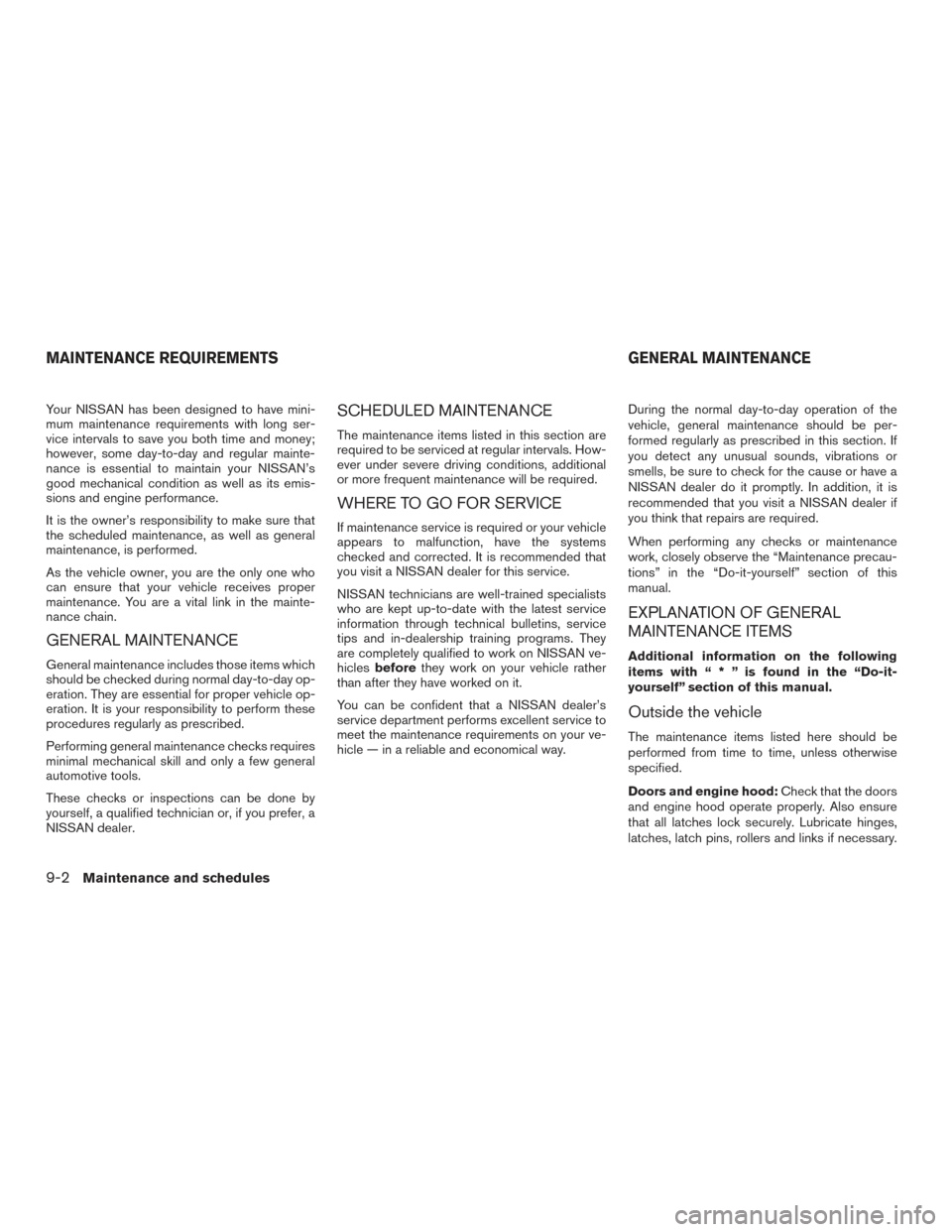
Your NISSAN has been designed to have mini-
mum maintenance requirements with long ser-
vice intervals to save you both time and money;
however, some day-to-day and regular mainte-
nance is essential to maintain your NISSAN’s
good mechanical condition as well as its emis-
sions and engine performance.
It is the owner’s responsibility to make sure that
the scheduled maintenance, as well as general
maintenance, is performed.
As the vehicle owner, you are the only one who
can ensure that your vehicle receives proper
maintenance. You are a vital link in the mainte-
nance chain.
GENERAL MAINTENANCE
General maintenance includes those items which
should be checked during normal day-to-day op-
eration. They are essential for proper vehicle op-
eration. It is your responsibility to perform these
procedures regularly as prescribed.
Performing general maintenance checks requires
minimal mechanical skill and only a few general
automotive tools.
These checks or inspections can be done by
yourself, a qualified technician or, if you prefer, a
NISSAN dealer.
SCHEDULED MAINTENANCE
The maintenance items listed in this section are
required to be serviced at regular intervals. How-
ever under severe driving conditions, additional
or more frequent maintenance will be required.
WHERE TO GO FOR SERVICE
If maintenance service is required or your vehicle
appears to malfunction, have the systems
checked and corrected. It is recommended that
you visit a NISSAN dealer for this service.
NISSAN technicians are well-trained specialists
who are kept up-to-date with the latest service
information through technical bulletins, service
tips and in-dealership training programs. They
are completely qualified to work on NISSAN ve-
hiclesbefore they work on your vehicle rather
than after they have worked on it.
You can be confident that a NISSAN dealer’s
service department performs excellent service to
meet the maintenance requirements on your ve-
hicle — in a reliable and economical way. During the normal day-to-day operation of the
vehicle, general maintenance should be per-
formed regularly as prescribed in this section. If
you detect any unusual sounds, vibrations or
smells, be sure to check for the cause or have a
NISSAN dealer do it promptly. In addition, it is
recommended that you visit a NISSAN dealer if
you think that repairs are required.
When performing any checks or maintenance
work, closely observe the “Maintenance precau-
tions” in the “Do-it-yourself” section of this
manual.
EXPLANATION OF GENERAL
MAINTENANCE ITEMS
Additional information on the following
items with“*”isfound in the “Do-it-
yourself” section of this manual.
Outside the vehicle
The maintenance items listed here should be
performed from time to time, unless otherwise
specified.
Doors and engine hood:
Check that the doors
and engine hood operate properly. Also ensure
that all latches lock securely. Lubricate hinges,
latches, latch pins, rollers and links if necessary.
MAINTENANCE REQUIREMENTS GENERAL MAINTENANCE
9-2Maintenance and schedules
Page 370 of 414
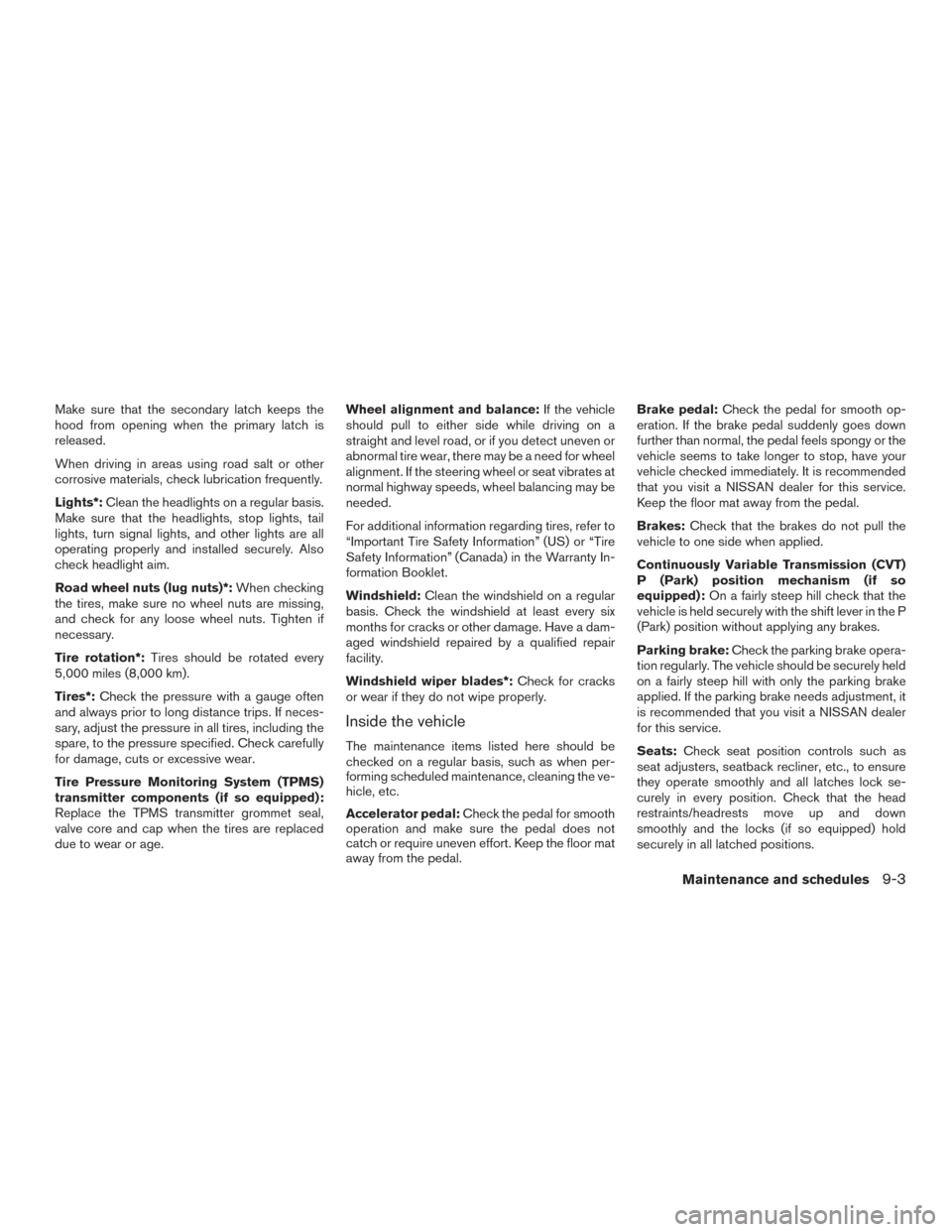
Make sure that the secondary latch keeps the
hood from opening when the primary latch is
released.
When driving in areas using road salt or other
corrosive materials, check lubrication frequently.
Lights*:Clean the headlights on a regular basis.
Make sure that the headlights, stop lights, tail
lights, turn signal lights, and other lights are all
operating properly and installed securely. Also
check headlight aim.
Road wheel nuts (lug nuts)*: When checking
the tires, make sure no wheel nuts are missing,
and check for any loose wheel nuts. Tighten if
necessary.
Tire rotation*: Tires should be rotated every
5,000 miles (8,000 km).
Tires*: Check the pressure with a gauge often
and always prior to long distance trips. If neces-
sary, adjust the pressure in all tires, including the
spare, to the pressure specified. Check carefully
for damage, cuts or excessive wear.
Tire Pressure Monitoring System (TPMS)
transmitter components (if so equipped):
Replace the TPMS transmitter grommet seal,
valve core and cap when the tires are replaced
due to wear or age. Wheel alignment and balance:
If the vehicle
should pull to either side while driving on a
straight and level road, or if you detect uneven or
abnormal tire wear, there may be a need for wheel
alignment. If the steering wheel or seat vibrates at
normal highway speeds, wheel balancing may be
needed.
For additional information regarding tires, refer to
“Important Tire Safety Information” (US) or “Tire
Safety Information” (Canada) in the Warranty In-
formation Booklet.
Windshield: Clean the windshield on a regular
basis. Check the windshield at least every six
months for cracks or other damage. Have a dam-
aged windshield repaired by a qualified repair
facility.
Windshield wiper blades*: Check for cracks
or wear if they do not wipe properly.
Inside the vehicle
The maintenance items listed here should be
checked on a regular basis, such as when per-
forming scheduled maintenance, cleaning the ve-
hicle, etc.
Accelerator pedal: Check the pedal for smooth
operation and make sure the pedal does not
catch or require uneven effort. Keep the floor mat
away from the pedal. Brake pedal:
Check the pedal for smooth op-
eration. If the brake pedal suddenly goes down
further than normal, the pedal feels spongy or the
vehicle seems to take longer to stop, have your
vehicle checked immediately. It is recommended
that you visit a NISSAN dealer for this service.
Keep the floor mat away from the pedal.
Brakes: Check that the brakes do not pull the
vehicle to one side when applied.
Continuously Variable Transmission (CVT)
P (Park) position mechanism (if so
equipped): On a fairly steep hill check that the
vehicle is held securely with the shift lever in the P
(Park) position without applying any brakes.
Parking brake: Check the parking brake opera-
tion regularly. The vehicle should be securely held
on a fairly steep hill with only the parking brake
applied. If the parking brake needs adjustment, it
is recommended that you visit a NISSAN dealer
for this service.
Seats: Check seat position controls such as
seat adjusters, seatback recliner, etc., to ensure
they operate smoothly and all latches lock se-
curely in every position. Check that the head
restraints/headrests move up and down
smoothly and the locks (if so equipped) hold
securely in all latched positions.
Maintenance and schedules9-3
Page 371 of 414
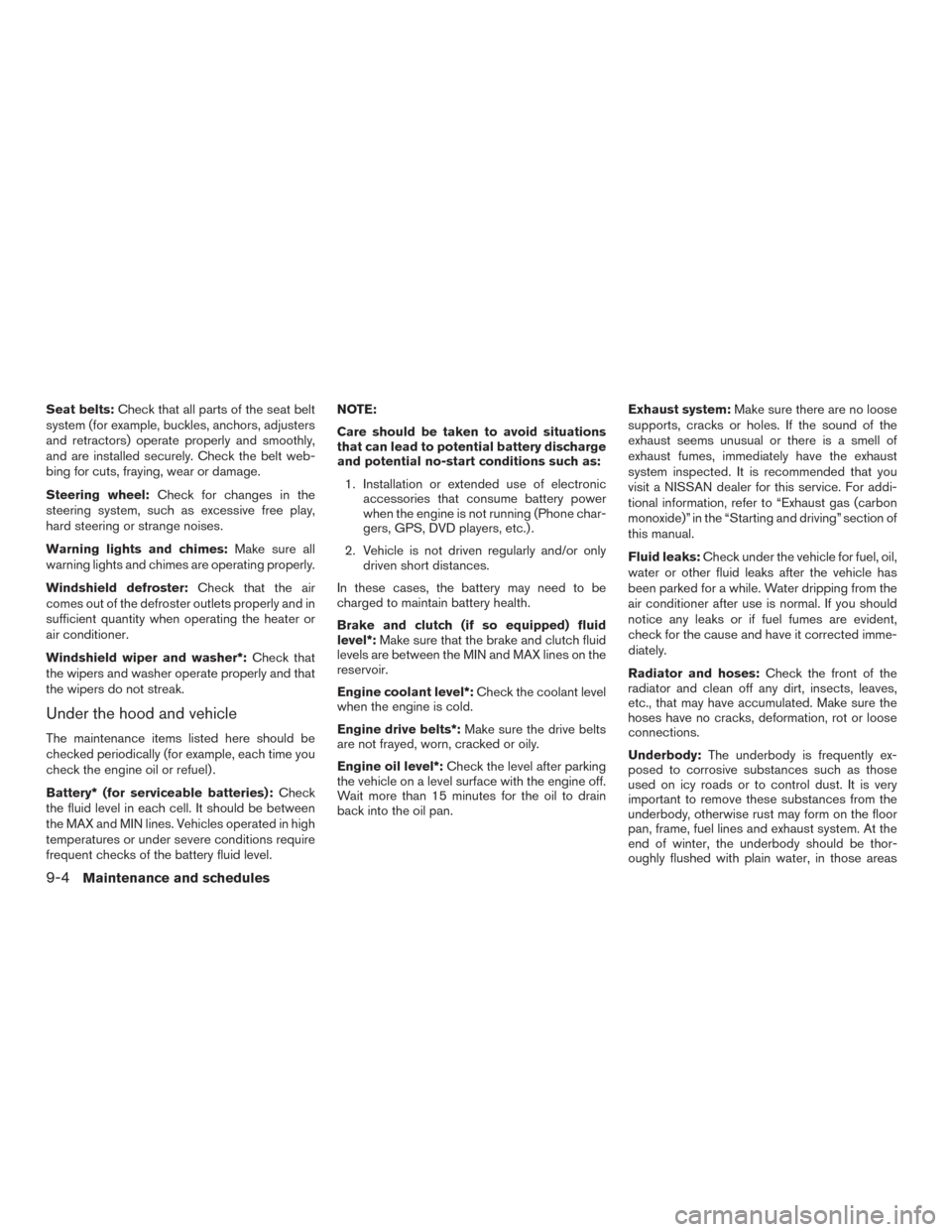
Seat belts:Check that all parts of the seat belt
system (for example, buckles, anchors, adjusters
and retractors) operate properly and smoothly,
and are installed securely. Check the belt web-
bing for cuts, fraying, wear or damage.
Steering wheel: Check for changes in the
steering system, such as excessive free play,
hard steering or strange noises.
Warning lights and chimes: Make sure all
warning lights and chimes are operating properly.
Windshield defroster: Check that the air
comes out of the defroster outlets properly and in
sufficient quantity when operating the heater or
air conditioner.
Windshield wiper and washer*: Check that
the wipers and washer operate properly and that
the wipers do not streak.
Under the hood and vehicle
The maintenance items listed here should be
checked periodically (for example, each time you
check the engine oil or refuel) .
Battery* (for serviceable batteries): Check
the fluid level in each cell. It should be between
the MAX and MIN lines. Vehicles operated in high
temperatures or under severe conditions require
frequent checks of the battery fluid level. NOTE:
Care should be taken to avoid situations
that can lead to potential battery discharge
and potential no-start conditions such as:
1. Installation or extended use of electronic accessories that consume battery power
when the engine is not running (Phone char-
gers, GPS, DVD players, etc.) .
2. Vehicle is not driven regularly and/or only driven short distances.
In these cases, the battery may need to be
charged to maintain battery health.
Brake and clutch (if so equipped) fluid
level*: Make sure that the brake and clutch fluid
levels are between the MIN and MAX lines on the
reservoir.
Engine coolant level*: Check the coolant level
when the engine is cold.
Engine drive belts*: Make sure the drive belts
are not frayed, worn, cracked or oily.
Engine oil level*: Check the level after parking
the vehicle on a level surface with the engine off.
Wait more than 15 minutes for the oil to drain
back into the oil pan. Exhaust system:
Make sure there are no loose
supports, cracks or holes. If the sound of the
exhaust seems unusual or there is a smell of
exhaust fumes, immediately have the exhaust
system inspected. It is recommended that you
visit a NISSAN dealer for this service. For addi-
tional information, refer to “Exhaust gas (carbon
monoxide)” in the “Starting and driving” section of
this manual.
Fluid leaks: Check under the vehicle for fuel, oil,
water or other fluid leaks after the vehicle has
been parked for a while. Water dripping from the
air conditioner after use is normal. If you should
notice any leaks or if fuel fumes are evident,
check for the cause and have it corrected imme-
diately.
Radiator and hoses: Check the front of the
radiator and clean off any dirt, insects, leaves,
etc., that may have accumulated. Make sure the
hoses have no cracks, deformation, rot or loose
connections.
Underbody: The underbody is frequently ex-
posed to corrosive substances such as those
used on icy roads or to control dust. It is very
important to remove these substances from the
underbody, otherwise rust may form on the floor
pan, frame, fuel lines and exhaust system. At the
end of winter, the underbody should be thor-
oughly flushed with plain water, in those areas
9-4Maintenance and schedules
Page 399 of 414
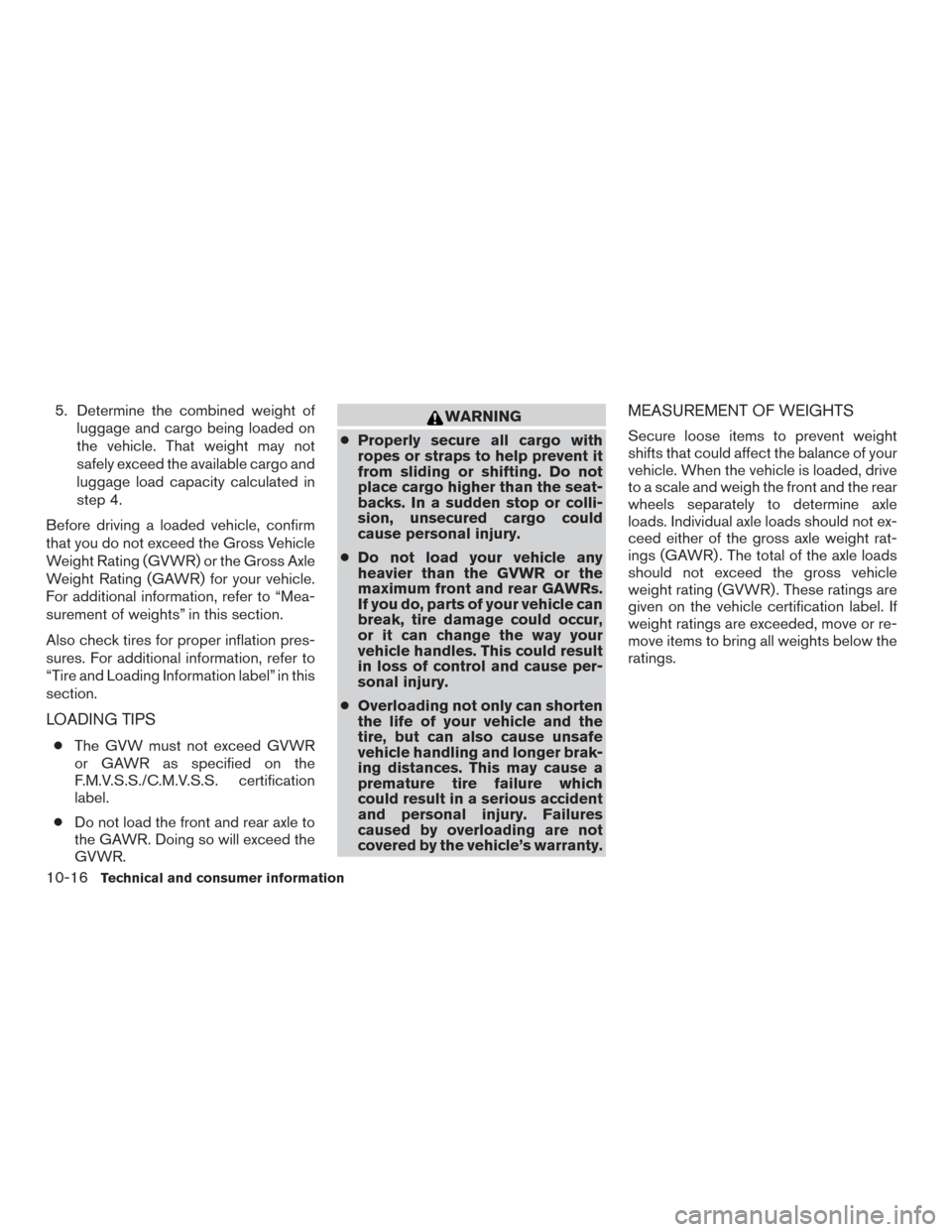
5. Determine the combined weight ofluggage and cargo being loaded on
the vehicle. That weight may not
safely exceed the available cargo and
luggage load capacity calculated in
step 4.
Before driving a loaded vehicle, confirm
that you do not exceed the Gross Vehicle
Weight Rating (GVWR) or the Gross Axle
Weight Rating (GAWR) for your vehicle.
For additional information, refer to “Mea-
surement of weights” in this section.
Also check tires for proper inflation pres-
sures. For additional information, refer to
“Tire and Loading Information label” in this
section.
LOADING TIPS
● The GVW must not exceed GVWR
or GAWR as specified on the
F.M.V.S.S./C.M.V.S.S. certification
label.
● Do not load the front and rear axle to
the GAWR. Doing so will exceed the
GVWR.
WARNING
● Properly secure all cargo with
ropes or straps to help prevent it
from sliding or shifting. Do not
place cargo higher than the seat-
backs. In a sudden stop or colli-
sion, unsecured cargo could
cause personal injury.
● Do not load your vehicle any
heavier than the GVWR or the
maximum front and rear GAWRs.
If you do, parts of your vehicle can
break, tire damage could occur,
or it can change the way your
vehicle handles. This could result
in loss of control and cause per-
sonal injury.
● Overloading not only can shorten
the life of your vehicle and the
tire, but can also cause unsafe
vehicle handling and longer brak-
ing distances. This may cause a
premature tire failure which
could result in a serious accident
and personal injury. Failures
caused by overloading are not
covered by the vehicle’s warranty.MEASUREMENT OF WEIGHTS
Secure loose items to prevent weight
shifts that could affect the balance of your
vehicle. When the vehicle is loaded, drive
to a scale and weigh the front and the rear
wheels separately to determine axle
loads. Individual axle loads should not ex-
ceed either of the gross axle weight rat-
ings (GAWR) . The total of the axle loads
should not exceed the gross vehicle
weight rating (GVWR) . These ratings are
given on the vehicle certification label. If
weight ratings are exceeded, move or re-
move items to bring all weights below the
ratings.
10-16
Technical and consumer information
Page 402 of 414
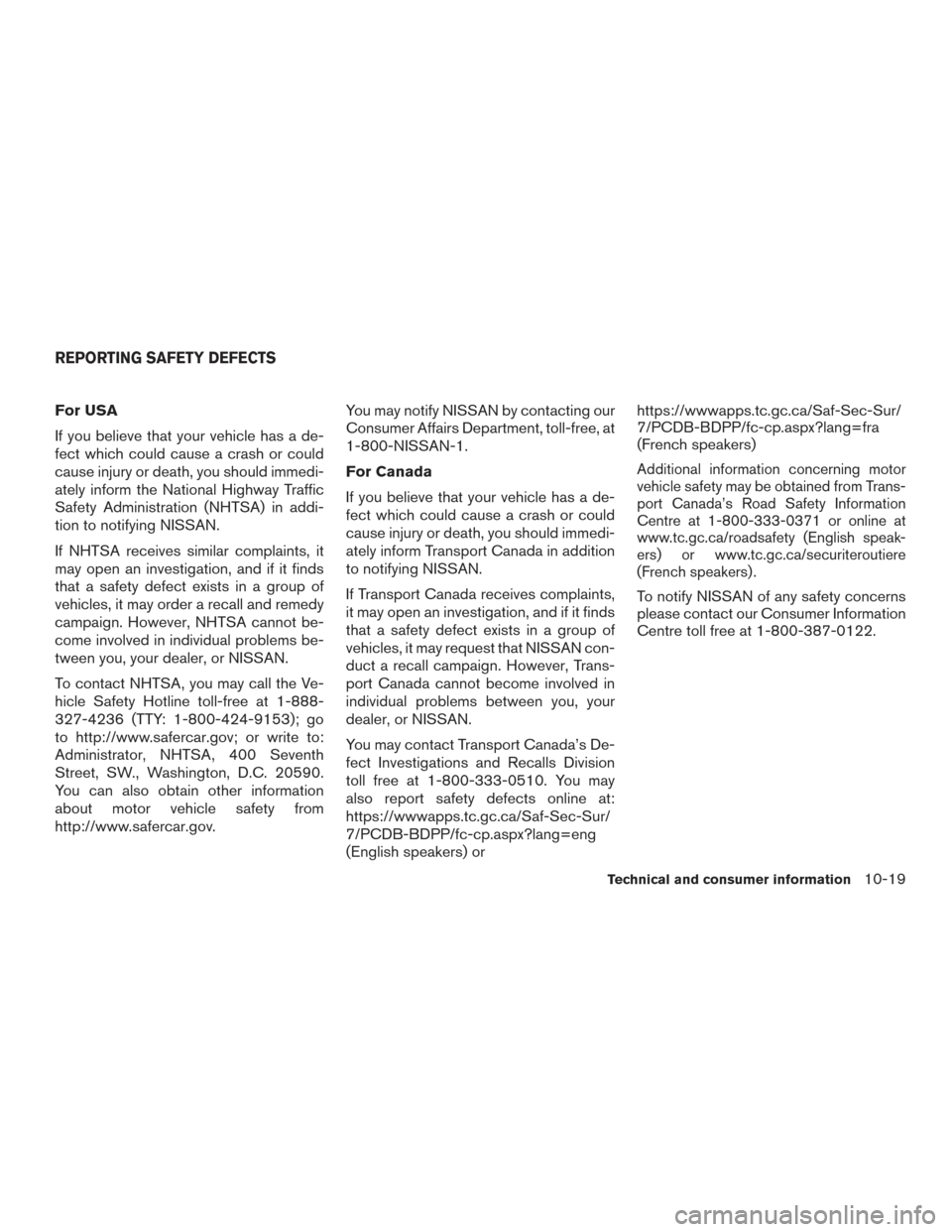
For USA
If you believe that your vehicle has a de-
fect which could cause a crash or could
cause injury or death, you should immedi-
ately inform the National Highway Traffic
Safety Administration (NHTSA) in addi-
tion to notifying NISSAN.
If NHTSA receives similar complaints, it
may open an investigation, and if it finds
that a safety defect exists in a group of
vehicles, it may order a recall and remedy
campaign. However, NHTSA cannot be-
come involved in individual problems be-
tween you, your dealer, or NISSAN.
To contact NHTSA, you may call the Ve-
hicle Safety Hotline toll-free at 1-888-
327-4236 (TTY: 1-800-424-9153); go
to http://www.safercar.gov; or write to:
Administrator, NHTSA, 400 Seventh
Street, SW., Washington, D.C. 20590.
You can also obtain other information
about motor vehicle safety from
http://www.safercar.gov.You may notify NISSAN by contacting our
Consumer Affairs Department, toll-free, at
1-800-NISSAN-1.
For Canada
If you believe that your vehicle has a de-
fect which could cause a crash or could
cause injury or death, you should immedi-
ately inform Transport Canada in addition
to notifying NISSAN.
If Transport Canada receives complaints,
it may open an investigation, and if it finds
that a safety defect exists in a group of
vehicles, it may request that NISSAN con-
duct a recall campaign. However, Trans-
port Canada cannot become involved in
individual problems between you, your
dealer, or NISSAN.
You may contact Transport Canada’s De-
fect Investigations and Recalls Division
toll free at 1-800-333-0510. You may
also report safety defects online at:
https://wwwapps.tc.gc.ca/Saf-Sec-Sur/
7/PCDB-BDPP/fc-cp.aspx?lang=eng
(English speakers) orhttps://wwwapps.tc.gc.ca/Saf-Sec-Sur/
7/PCDB-BDPP/fc-cp.aspx?lang=fra
(French speakers)
Additional information concerning motor
vehicle safety may be obtained from Trans-
port Canada’s Road Safety Information
Centre at 1-800-333-0371 or online at
www.tc.gc.ca/roadsafety (English speak-
ers) or www.tc.gc.ca/securiteroutiere
(French speakers) .
To notify NISSAN of any safety concerns
please contact our Consumer Information
Centre toll free at 1-800-387-0122.
REPORTING SAFETY DEFECTS
Technical and consumer information10-19
Page 409 of 414
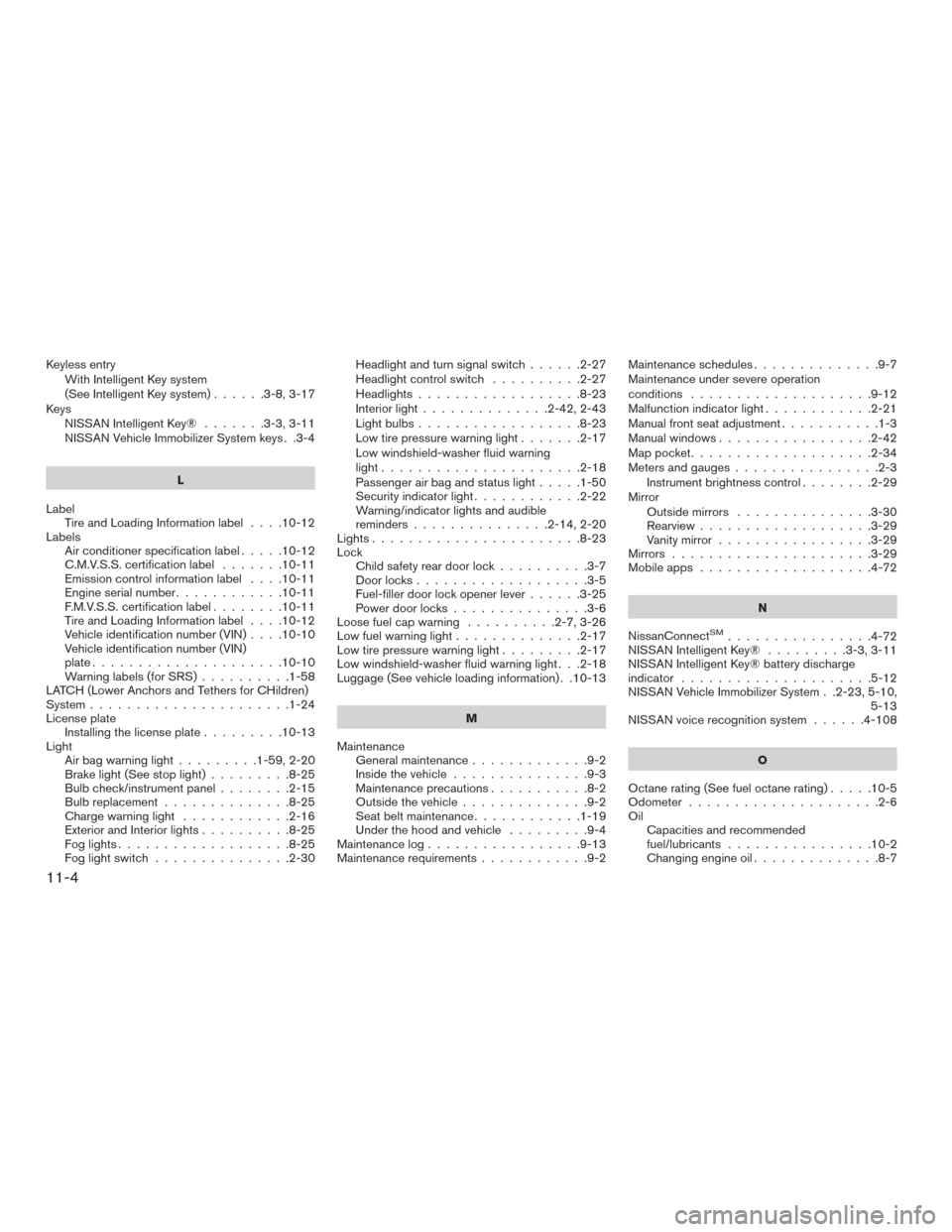
Keyless entryWith Intelligent Key system
(See Intelligent Key system) ......3-8,3-17
Keys NISSAN Intelligent Key® .......3-3,3-11
NISSAN Vehicle Immobilizer System keys . .3-4
L
Label Tire and Loading Information label ....10-12
Labels Air conditioner specification label .....10-12
C.M.V.S.S. certification label .......10-11
Emissioncontrolinformationlabel ....10-11
Engine serial number ............10-11
F.M.V.S.S. certification label ........10-11
Tire and Loading Information label ....10-12
Vehicle identification number (VIN) ....10-10
Vehicle identification number (VIN)
plate .....................10-10
Warning labels (for SRS) ..........1-58
LATCH (Lower Anchors and Tethers for CHildren)
System ......................1-24
License plate Installing the license plate .........10-13
Light Airbagwarninglight.........1-59,2-20
Brake light (See stop light) .........8-25
Bulb check/instrument panel ........2-15
Bulb replacement ..............8-25
Charge warning light ............2-16
ExteriorandInteriorlights..........8-25
Foglights...................8-25
Foglightswitch ...............2-30 Headlight and turn signal switch
......2-27
Headlight control switch ..........2-27
Headlights..................8-23
Interiorlight..............2-42,2-43
Lightbulbs..................8-23
Low tire pressure warning light .......2-17
Low windshield-washer fluid warning
light......................2-18
Passenger air bag and status light .....1-50
Security indicator light ............2-22
Warning/indicator lights and audible
reminders ...............2-14,2-20
Lights.......................8-23
Lock Child safety rear door lock ..........3-7
Door locks ...................3-5
Fuel-filler door lock opener lever ......3-25
Power door locks ...............3-6
Loose fuel cap warning ..........2-7,3-26
Lowfuelwarninglight..............2-17
Low tire pressure warning light .........2-17
Low windshield-washer fluid warning light . . .2-18
Luggage (See vehicle loading information) . .10-13
M
Maintenance Generalmaintenance.............9-2
Insidethevehicle...............9-3
Maintenance precautions ...........8-2
Outside the vehicle ..............9-2
Seatbeltmaintenance............1-19
Underthehoodandvehicle .........9-4
Maintenancelog.................9-13
Maintenancerequirements............9-2 Maintenance schedules
..............9-7
Maintenance under severe operation
conditions ....................9-12
Malfunction indicator light ............2-21
Manual front seat adjustment ...........1-3
Manual windows .................2-42
Mappocket....................2-34
Meters and gauges ................2-3
Instrument brightness control ........2-29
Mirror Outside mirrors ...............3-30
Rearview ...................3-29
Vanity mirror .................3-29
Mirrors ......................3-29
Mobileapps ...................4-72
N
NissanConnect
SM................4-72
NISSAN Intelligent Key® .........3-3,3-11
NISSAN Intelligent Key® battery discharge
indicator .....................5-12
NISSAN Vehicle Immobilizer System . .2-23, 5-10, 5-13
NISSAN voice recognition system ......4-108
O
Octane rating (See fuel octane rating) .....10-5
Odometer .....................2-6
Oil Capacities and recommended
fuel/lubricants ................10-2
Changingengineoil..............8-7
11-4
Page 410 of 414
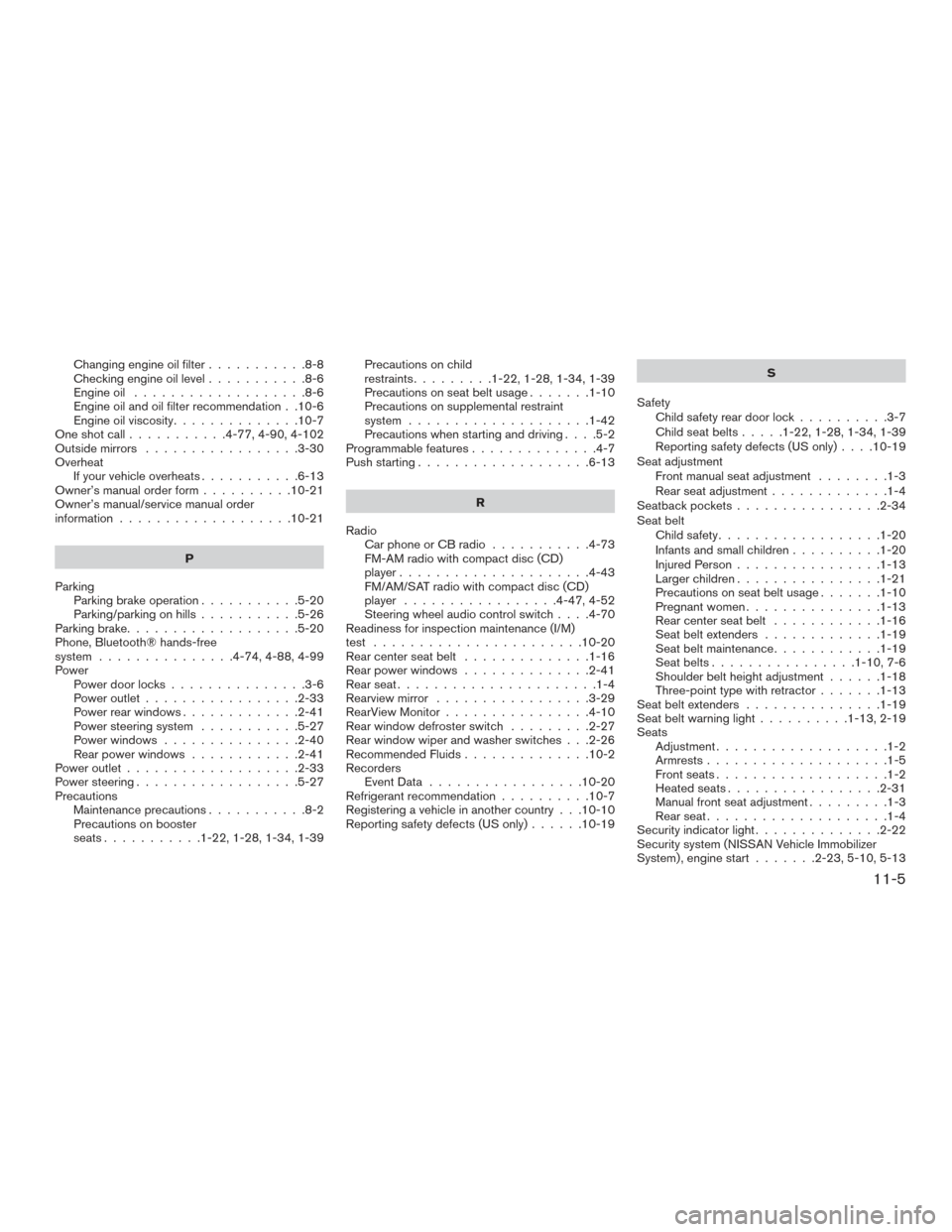
Changing engine oil filter...........8-8
Checking engine oil level ...........8-6
Engine oil ...................8-6
Engine oil and oil filter recommendation . .10-6
Engine oil viscosity ..............10-7
Oneshotcall...........4-77,4-90,4-102
Outside mirrors .................3-30
Overheat Ifyourvehicleoverheats...........6-13
Owner’s manual order form ..........10-21
Owner’s manual/service manual order
information ...................10-21
P
Parking Parking brake operation ...........5-20
Parking/parking on hills ...........5-26
Parking brake ...................5-20
Phone, Bluetooth® hands-free
system ...............4-74,4-88,4-99
Power Power door locks ...............3-6
Power outlet .................2-33
Power rear windows .............2-41
Power steering system ...........5-27
Power windows ...............2-40
Rear power windows ............2-41
Power outlet ...................2-33
Power steering ..................5-27
Precautions Maintenance precautions ...........8-2
Precautions on booster
seats...........1-22,1-28,1-34,1-39 Precautions on child
restraints
.........1-22,1-28,1-34,1-39
Precautions on seat belt usage .......1-10
Precautions on supplemental restraint
system ....................1-42
Precautions when starting and driving ....5-2
Programmablefeatures..............4-7
Push starting ...................6-13
R
Radio Car phone or CB radio ...........4-73
FM-AM radio with compact disc (CD)
player .....................4-43
FM/AM/SAT radio with compact disc (CD)
player .................4-47,4-52
Steering wheel audio control switch ....4-70
Readiness for inspection maintenance (I/M)
test .......................10-20
Rear center seat belt ..............1-16
Rear power windows ..............2-41
Rearseat......................1-4
Rearview mirror .................3-29
RearView Monitor ................4-10
Rear window defroster switch .........2-27
Rear window wiper and washer switches . . .2-26
Recommended Fluids ..............10-2
Recorders EventData .................10-20
Refrigerant recommendation ..........10-7
Registering a vehicle in another country . . .10-10
Reporting safety defects (US only) ......10-19 S
Safety Child safety rear door lock ..........3-7
Child seat belts .....1-22,1-28,1-34,1-39
Reporting safety defects (US only) ....10-19
Seat adjustment Front manual seat adjustment ........1-3
Rear seat adjustment .............1-4
Seatbackpockets................2-34
Seat belt Child safety ..................1-20
Infants and
small children ..........1-20
Injured Person ................1-13
Largerchildren................1-21
Precautions on seat belt usage .......1-10
Pregnant women ...............1-13
Rear center seat belt ............1-16
Seatbeltextenders .............1-19
Seatbeltmaintenance............1-19
Seatbelts................1-10,7-6
Shoulder belt height adjustment ......1-18
Three-point type with retractor .......1-13
Seat belt extenders ...............1-19
Seatbeltwarninglight..........1-13,2-19
Seats Adjustment ...................1-2
Armrests....................1-5
Frontseats...................1-2
Heatedseats.................2-31
Manualfrontseatadjustment.........1-3
Rearseat....................1-4
Security indicator light ..............2-22
Security system (NISSAN Vehicle Immobilizer
System) , engine start .......2-23,5-10,5-13
11-5
Page 412 of 414
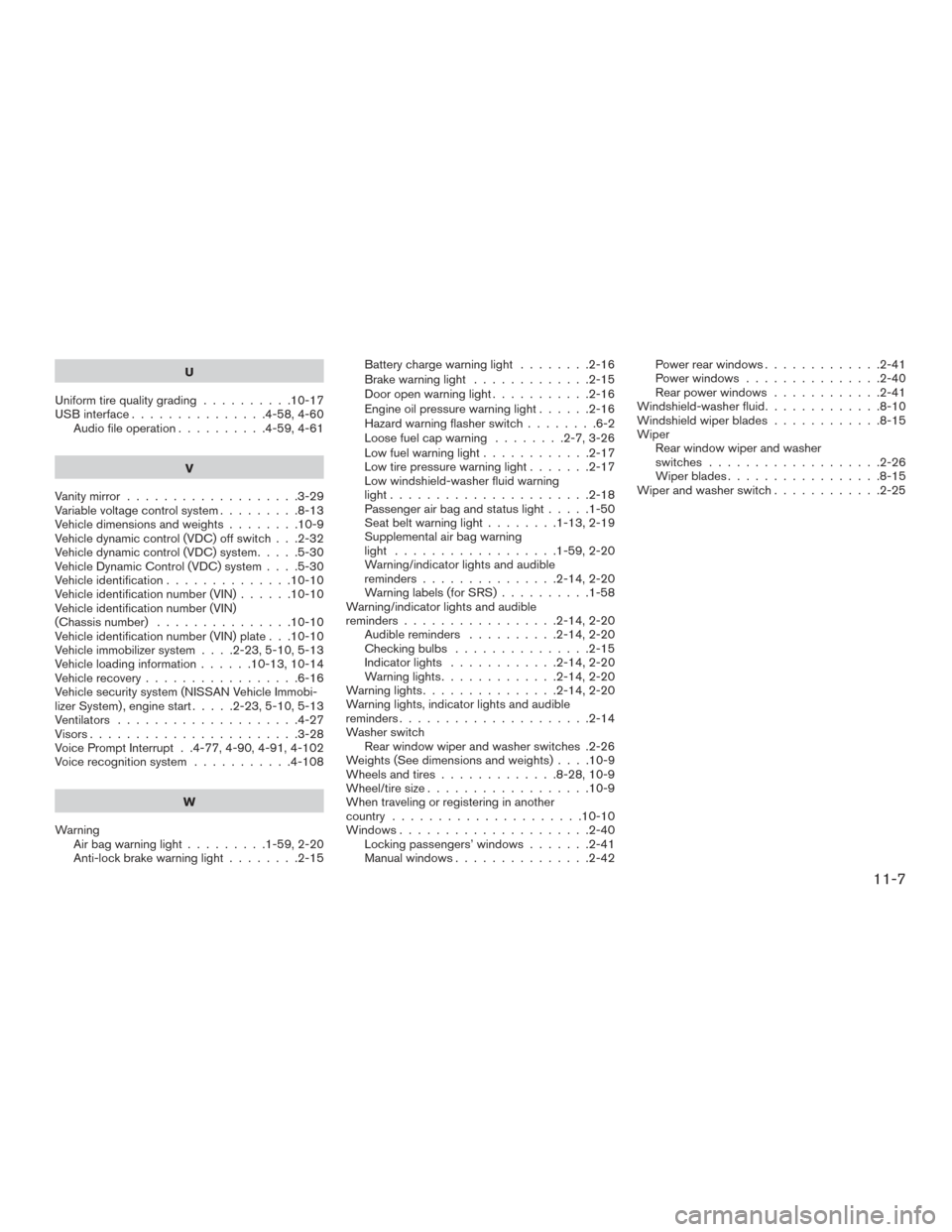
U
Uniform tire quality grading ..........10-17
USB interface ...............4-58,4-60
Audio file operation ..........4-59,4-61
V
Vanity mirror ...................3-29
Variable voltage control system .........8-13
Vehicledimensionsandweights........10-9
Vehicle dynamic control (VDC) off switch . . .2-32
Vehicle dynamic control (VDC) system .....5-30
Vehicle Dynamic Control (VDC) system ....5-30
Vehicle identification ..............10-10
Vehicle identification number (VIN) ......10-10
Vehicle identification number (VIN)
(Chassis number) ...............10-10
Vehicle identification number (VIN) plate . . .10-10
Vehicle immobilizer system ....2-23,5-10,5-13
Vehicleloadinginformation......10-13,10-14
Vehicle recovery .................6-16
Vehicle security system (NISSAN Vehicle Immobi-
lizer System) , engine start .....2-23,5-10,5-13
Ventilators ....................4-27
Visors.......................3-28
Voice Prompt Interrupt . .4-77, 4-90, 4-91, 4-102
Voice recognition system ...........4-108
W
Warning Airbagwarninglight.........1-59,2-20
Anti-lock brake warning light ........2-15Battery charge warning light
........2-16
Brake warning light .............2-15
Door open warning light ...........2-16
Engine oil pressure warning light ......2-16
Hazard warning flasher switch ........6-2
Loose fuel cap warning ........2-7,3-26
Lowfuelwarninglight............2-17
Low tire pressure warning light .......2-17
Low windshield-washer fluid warning
light......................2-18
Passenger air bag and status light .....1-50
Seatbeltwarninglight........1-13,2-19
Supplemental air bag warning
light ..................1-59,2-20
Warning/indicator lights and audible
reminders...............2-14,2-20
Warning labels (for SRS) ..........1-58
Warning/indicator lights and audible
reminders.................2-14,2-20 Audible reminders ..........2-14,2-20
Checking bulbs ...............2-15
Indicatorlights ............2-14,2-20
Warninglights.............2-14,2-20
Warninglights...............2-14,2-20
Warning lights, indicator lights and audible
reminders.....................2-14
Washer switch Rear window wiper and washer switches .2-26
Weights(Seedimensionsandweights)....10-9
Wheels and tires .............8-28,10-9
Wheel/tire size ..................10-9
When traveling or registering in another
country .....................10-10
Windows .....................2-40
Locking passengers’ windows .......2-41
Manual windows ...............2-42 Power rear windows
.............2-41
Power windows ...............2-40
Rear power windows ............2-41
Windshield-washerfluid.............8-10
Windshieldwiperblades............8-15
Wiper Rear window wiper and washer
switches...................2-26
Wiperblades.................8-15
Wiper and washer switch ............2-25
11-7